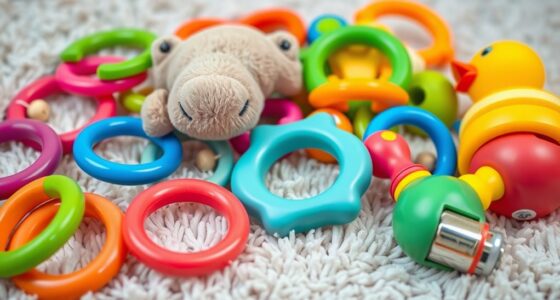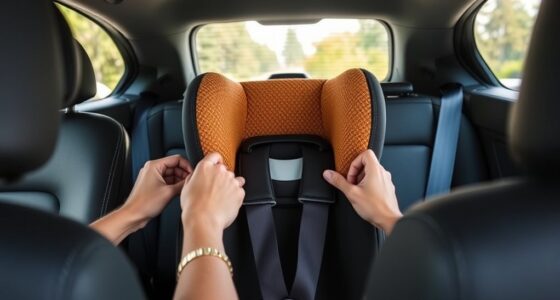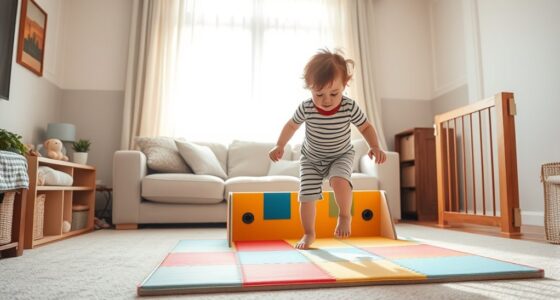To keep your baby safe during bath time, always test water temperature with your wrist or elbow to verify it’s around 98-100°F, and never rely solely on hand checks. Use non-slip mats inside and outside the tub, stay close and supervise constantly, and organize bath supplies beforehand to prevent accidents. Be mindful of your child’s stability and avoid hot water that can cause burns. Continue exploring these safety tips to make bath time both safe and enjoyable.
Key Takeaways
- Always test water temperature with wrist or elbow to ensure it’s around 98-100°F before bathing your baby.
- Never leave your baby unattended in the tub, even for a moment, to prevent drowning or accidents.
- Use non-slip mats inside the tub and on bathroom floors to prevent slips and falls.
- Keep bath supplies within reach to avoid reaching or slipping during bath time.
- Supervise your baby closely, supporting their head and body throughout the bath for safety.

Have you ever wondered how to keep your child safe during bath time? It’s a common concern, and the key lies in paying close attention to water temperature and slip hazards. Ensuring the water isn’t too hot prevents burns and discomfort, while addressing slip hazards keeps your little one from slipping and falling, which can cause serious injuries. You want bath time to be a safe, enjoyable experience, so taking these precautions makes all the difference.
First, always test the water temperature before placing your child in the tub. Use your wrist or elbow, as these areas are more sensitive than your hands. The water should feel warm but not hot—around 98 to 100 degrees Fahrenheit. Many parents forget how quickly water temperature can change, especially if the tap pressure is high or if water has been sitting in the pipes for a while. To avoid surprises, consider installing a thermometer in the bath or using a bath water temperature gauge. Never rely solely on your hand, as it can be less sensitive. Consistently checking the water temperature helps prevent accidental burns, which can happen in seconds if the water is too hot. Proper water temperature is vital for preventing injuries and ensuring comfort during bath time.
Always test bath water with your wrist or elbow to prevent burns.
Slip hazards are another essential concern. Bathtubs and bathroom floors can become very slippery when wet, increasing the risk of falls. To minimize this danger, use a non-slip mat inside the tub and on the bathroom floor. These mats provide better traction and help keep your child steady while they’re splashing and playing. Always supervise your child closely during bath time; never leave them unattended, even for a moment. Keep a hand on your child at all times to prevent slips or tumbles. If your child is very young or still learning to sit, consider using a bath seat or support that’s designed for safety, but remember that these are not substitutes for constant supervision.
Additionally, keep the bathroom well-organized. Avoid clutter around the tub that could cause your child to trip or knock over objects. Make sure all bath supplies—like soap, shampoo, and toys—are within easy reach before you start, so you won’t have to step away to grab something while your child is in the tub. Also, consider the height of your tub and your stance; use a sturdy, non-slip step stool if needed to comfortably reach your child without overextending. Remember, the goal is to create a safe environment that minimizes risks from water temperature fluctuations and slip hazards, allowing your child to enjoy bath time while staying safe.
Conclusion
Remember, your vigilance makes all the difference during bath time. Always stay within arm’s reach and never leave your baby unattended, even for a moment. Did you know that drowning is the leading cause of injury-related deaths in children under one? Keeping these safety tips in mind can help prevent accidents and ensure bath time remains a fun, safe experience for your little one. Your attentiveness cultivates a secure environment where your baby can enjoy their bath confidently.










